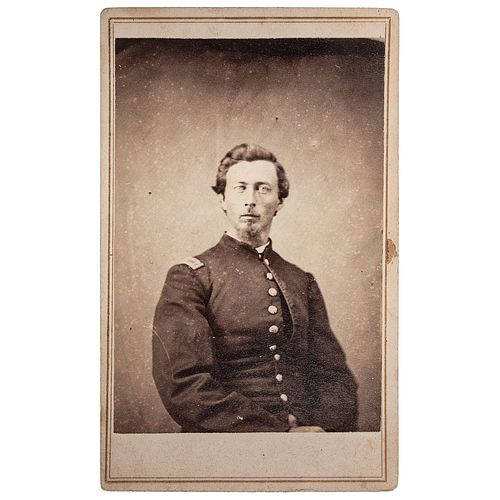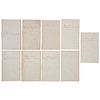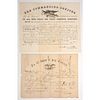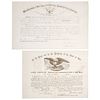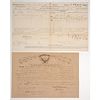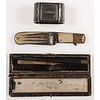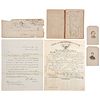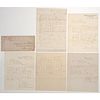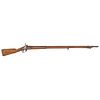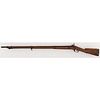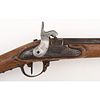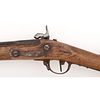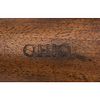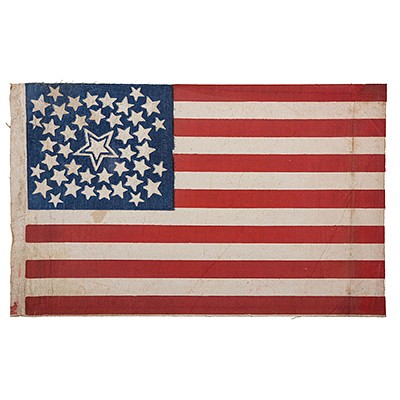Civil War Archive of Anson Hart Robbins, 7th OH Volunteers, 37th Battalion OH Volunteers, 150th OH National Guard, and 8th US Colored Heavy Artillery
About Seller
6270 Este Ave.
Cincinnati , OH 45232
United States
With offices in Cincinnati, Cleveland and Denver, Cowan’s holds over 40 auctions each year, with annual sales exceeding $16M. We reach buyers around the globe, and take pride in our reputation for integrity, customer service and great results. A full-service house, Cowan’s Auctions specializes in Am...Read more
Two ways to bid:
- Leave a max absentee bid and the platform will bid on your behalf up to your maximum bid during the live auction.
- Bid live during the auction and your bids will be submitted real-time to the auctioneer.
Bid Increments
| Price | Bid Increment |
|---|---|
| $0 | $25 |
| $500 | $50 |
| $1,000 | $100 |
| $2,000 | $250 |
| $5,000 | $500 |
| $10,000 | $1,000 |
| $20,000 | $2,500 |
| $50,000 | $5,000 |
| $100,000 | $10,000 |
About Auction
Nov 19, 2020
Cowan’s Auctions, a Hindman Company, is pleased to present the November 19 Fall Auction, featuring over 400 lots of historically significant photography, manuscript material, artwork, and other ephemera dating from the 18th through the early 20th century, including the Civil War. Cowan's Auctions dawnie@cowans.com
- Lot Description
Archive comprised of over 100 items identified to Anson Hart Robbins and his family, ca 1861-1867, including his 1763 Charlieville flintlock musket converted to percussion in 1860 and sold to the United States and imported in 1861. Marked on stock "Ohio," with inspector's proof mark on top of barrel; CDV of Robbins; 9 diaries kept by Robbins from October 1860-May 1867; what is believed to be all of Robbins' enrollments, discharges, and enlistment certificates; 4 diaries kept by Robbins' wife; and assorted personal items, such as a folding fork, a pen in original box, and a silver napkin ring with "Robbins" engraved on the top, marked as being from the 150th Ohio National Guard.Anson Hart Robbins was born in Connecticut in 1838 but moved to Ohio with his family as a child. His college record suggests that he associates Cleveland as his Ohio home. Robbins attended Oberlin College, a Liberal Arts school about 35 miles southwest of Cleveland. From its founding Oberlin was abolitionist and coeducational. It became the first school to grant baccalaureate degrees to both African Americans (1844) and women (after 1837). This philosophy was important in Robbins' life since he met his wife (Lucy Kinney '67) at Oberlin and went on to do missionary work out West, mostly among American Indians.When the Civil War broke out, the 7th Ohio Volunteer Infantry Regiment was recruited primarily from Oberlin and the surrounding area. Robbins enlisted in Co. C on April 21, 1861 for a 3-month term. After being discharged, he re-enlisted in the 7th Ohio for 3 years, but was discharged for disability (wounded) in July 1862. He enlisted again as a corporal, Co. A, 37th Battalion OVI in August 1863. In May 1864 he was promoted to sergeant in Co. K of the 150th Ohio National Guard. He later took the Lieutenant's exam (passed) and was commissioned to 1st lieutenant, 8th Regiment US Colored Artillery (Heavy). He was discharged in February 1866 at Victoria, Texas from the 8th USCA and from the Ohio National Guard in May 1866. Robbins' appointments, discharges, and associated documents are present in this collection. A CDV of Robbins, taken at Lavaca, Texas, accompanies the lot as well as his book of accounts for the 8th USCA and 2 CDVs of men with whom he served in the 8th USCA, Captain George W. Cox, Acting Adjutant (S.M. Fassett: Chicago, signed on verso) and Lieutenant James H. Dony (Charles Foedisch: Honesdale, PA, signed on verso). The archive also features 9 small journals kept by Robbins, each a few pages stapled together. Three are war-dated: Oct. 1860-April 1863 (13pp); April 3, 1864-Nov. 13, 1864 (23pp); and Feb. 8, 1865 – June 7, 1865 (14pp). The other six are post-war: June 10-Aug. 26, 1865 (14pp); Aug. 27-Nov. 8, 1865 (14pp); Nov. 10, 1865-Jan. 25, 1866 (30pp); Jan. 26, 1866-May 12, 1866 (30pp); May 13, 1866-Mar. 10, 1867 (52pp); and Mar. 10, 1867-May 19, 1867 (5pp). The first journal sets up his reason for beginning to keep these - although he is on-again, off-again in his writing. (Oberlin, Oct. 28/60): “I have professed to be a follower of Christ for 3 years, but I now see that instead of making the glory of God the chief end of my life I have been seeking my own glory most of the time…”From the journal of 1864 (24pp): Fort Stevens, July 17, 64: “…Monday morning the rebels advanced on this fort with a line of skirmishers continuing their fire till Tuesday evening when our forces charged upon them and quite a battle followed, stopped [sic] only by the darkness. The next morning rebels were not in sight and now every thing has resumed its usual quiet….” Fort Stevens July 31st: “…Ever since I was in the army three years ago I had desired to see a little more of army life, and for more than a year I have been thinking of applying for a commission in a colored regt. …As I am so near Washington I went before Gen. Casey’s Board this week and passed as Lieut. Now if I receive an appointment, I do not know whether I ought to accept or not…” (Obviously, he did.) The last war-date journal (14pp) takes a more day-by-day format: "15th Saturday AM arrived at Pittsburgh and heard of the Presidents death… 18th Arrived at Washington 3 AM. Remained here till the 21st staying at the Soldiers rest. Tuesday (18th) and Thursday saw the Pres. Remains. Wednesday saw the procession as it passed up Pa. Ave.“The immediate post-war journal dating from June 10-Aug. 26, 1865 (14pp) includes an entry in which Robbins notes from Texas: "Found three other vessels of our fleet here also a gun boat doing blockade duty. This boat had not had any mail for a month and those on board did not know of the capture of Jeff Davis or the surrender of Kirby Smith." He also references his time working on the railroad in some post-war entries. On December 20, 1870, Anson Robbins and Lucy Kinney were married. They would have four children - Frederick, Rose, Mary, and Lucy. A portion of this collection relates to Lucy and the children and includes 4 journals written by Lucy, each gatherings of 13 - 18 leaves. The journals date from the following years: June 1864-1865; 1865-1867; 1870-1872; 1872, 1877-1879, 1882-1884. Additional family items include a “Diary of Rose Kinney, 1890-1895. Was in Ruk (Truk) 7 years, doing missionary work, back in US in 1897. 12mo, marbled paper boards, leather spine, 68 leaves (136pp); 2 children's books (readers), in rather rough condition; 5 spoons (with monogram "L.K.R."); and 7 butter knives. More than 40 important documents and letters related to Robbins are included, such as pension communications, special and generals orders, requests for leave, resignation, results from the Board of Examiners, Instructions relating to the US Military Railroad rates for travel, a later copy of the marriage license, a statement from the Church Council that Robbins had been ordained, a letter of recommendation for Lucy (as teacher), and communications with the 7th OVI Association. Rosters of the 7th Regiment for 1896, 1901, 1903, 1908, 1909, and 1927 are also enclosed, as well as a Memorial of the 150th Ohio, Co. K. After the war, Robbins trained as a minister/missionary. His work was in North America. Many of the covers included here are addressed to South Dakota towns. There is a hint that Robbins also worked in the Southwest and died in California in 1937. He remained in the West for most of the rest of his post-war life, but did return to Ohio for some of the reunions.Cdvs of Cox and Dony trimmed at top, the first to an arch.
Condition
- Shipping Info
-
Buyers are required to pay for all packing, shipping and insurance charges. Overseas duty charges are the responsibility of the successful Bidder. Be aware that for larger and/or valuable items, shipping charges can be substantial. - If there is no shipping amount on listed your invoice, you will need to make arrangements to pick up or ship your purchase through an alternative shipping company. Our shipping department can be contacted at 513.871.1670 (ext. 219) or email shipping@cowans.com. - Shipping charges include insurance for your order while in transit. If you have private insurance we will adjust your charge to include only packing and shipping. - Please allow 14 – 21 days after payment to package and ship your purchase as carefully as possible.
-
- Buyer's Premium



 EUR
EUR CAD
CAD AUD
AUD GBP
GBP MXN
MXN HKD
HKD CNY
CNY MYR
MYR SEK
SEK SGD
SGD CHF
CHF THB
THB